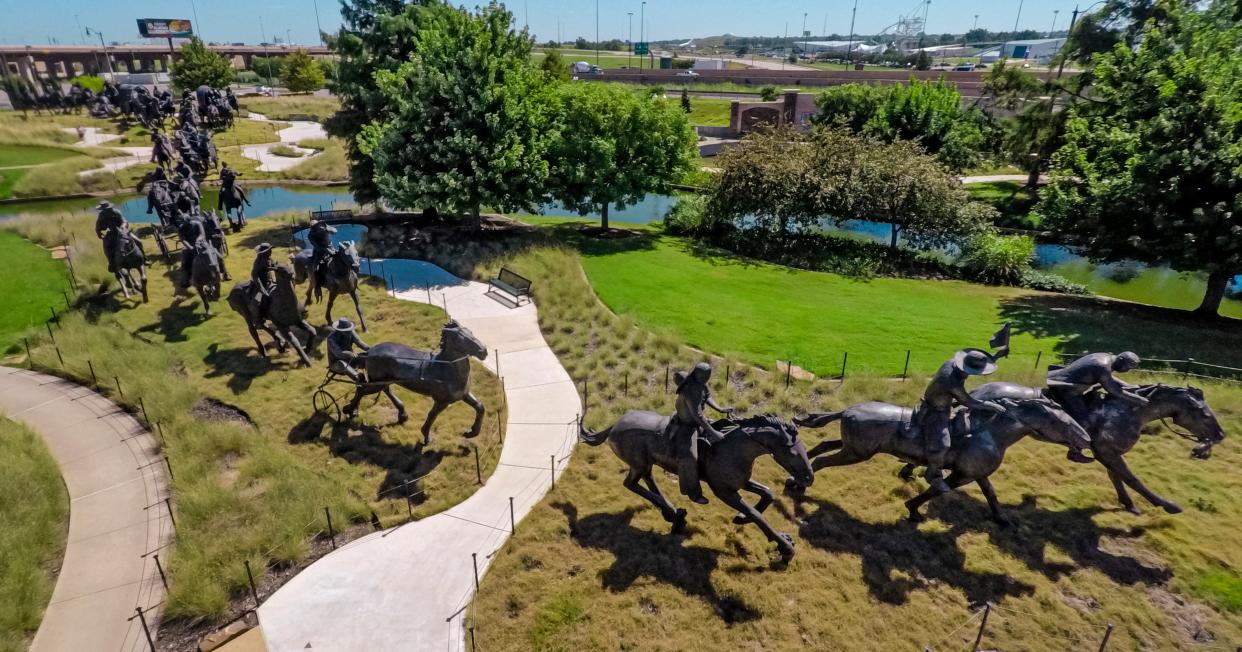Oklahoma Land Run anniversary: What to know about rocky history, Bricktown sculpture updates
Over 130 years ago this month, thousands of settlers rushed to stake their claim of 160 acres in the so-called "unassigned lands" of Oklahoma territory, marking the beginning of what would eventually become the state of Oklahoma.
That event, which started on April 22, 1889, is also a source of generational trauma for many Oklahoma tribal members, who are reminded by the 1889 Oklahoma Land Run of their ancestors' forcible removal here. There are 39 federally recognized tribes based in Oklahoma today, many of whom were granted or sold land that was a fraction of the areas they previously occupied for centuries.
Since their removal, they have endured decades of hardship, from boarding schools where students were forced to cut their hair, only speak English and were often abused, to continued loss of land through government allotments and subsequent land runs, and suppression of tribal sovereignty.
Here's what to know about the 1889 land run, how it originated, and the effects it still has today.
Oklahoma Land Rush: Where did 'Unassigned Lands' come from?
The land, nearly 1.9 million acres, was deemed open for settlement 23 years after the Five Tribes (Cherokee, Choctaw, Chickasaw, Muscogee/Creek, and Seminole) signed new treaties with the United States in 1866, according to the Oklahoma Historical Society.
The tribes ceded portions of their land — along with agreeing to end slavery, allow railroads to enter the area and grant former slaves full tribal citizenship — after signing treaties with and fighting for the Confederacy during the Civil War.
Much of that land was used to remove other tribes to the area, the Oklahoma Historical Society said, including the Cheyenne, Arapaho, Kiowa, Comanche and others.
But a large portion of land in the center of the state remained empty, and was eventually deemed "unassigned." There were campaigns to open the land up for settlement, but because of stipulations in 1866 treaties with the Creek and Seminole, the land was supposed to be used only for re-settlement of other native tribes.
But in 1889, the Creek and Seminole tribes presented proposals to relinquish any claim they previously had on the land, placing the land in the public domain.
The legal basis for opening the Oklahoma District, now called the Unassigned Lands, came
So in 1889, in the U.S. Congress amended the Indian Appropriations Bill to authorize President Benjamin Harrison to proclaim the two-million-acre region open for settlement. That spring, would-be settlers flooded the area in preparation, and on April 22, 1889, guns and cannons went off at noon, marking the "opening" of Oklahoma for non-native settlement.
Changes coming near Oklahoma City land run monument

For decades, the land run has been celebrated and even re-enacted at elementary schools. But those events have drawn protest from groups like the Society to Protect Indigenous Rights and Indigenous Treaties (SPIRIT), and many schools have stopped the practice.
But a permanent, bronze, larger-than-life monument to the land run stands tall in Lower Bricktown. A set of 45 statues depicts the event, stretching 365 feet across the southern end of the Bricktown Canal.
The monument, created by Oklahoma artist and citizen of the Muscogee (Creek) Nation Paul Moore, has been the recipient of protest since 2007 when SPIRIT formed to oppose centennial statehood celebrations.
The group again protested the monument and its heroic depiction of land run participants during the summer of 2020 and the racial reckoning which was bringing down monuments across the nation that honored people like Christopher Columbus and Confederate Army generals.
The group met with Oklahoma City Mayor David Holt, who rejected a proposal to tear down the monument completely but helped connect the group with the late city arts liaison Robbie Kienzle.
Since then, the group and the city have been working together to provide more context to the monument, specifically from the perspective of indigenous peoples. A report was presented in 2022 to the Oklahoma City Arts Commission — compiled by mother-and-son Anita Fields, who is Osage and Muscogee, and Yatika Fields, who is Osage, Muscogee and Cherokee — which determined the monument is one-sided and "hurtful" to Oklahoma's Indigenous communities.
Randy Marks, Oklahoma City's Arts Program Planner, said the city expects to announce within the next three months a Request for Proposals for a "cultural exhibit" that will be adjacent to the land run monument.
"The exhibit will convey an indigenous perspective on the indigenous cultural and historical context leading up to and including the land run event," Marks said.
This article originally appeared on Oklahoman: Oklahoma Land Run: History, updates at OKC Bricktown monument
